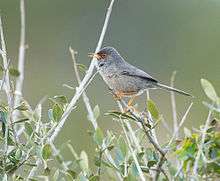Balearic warbler
Balearic warbler (Curruca balearica) is a typical warbler, genus Curruca. It is endemic to the Balearic Islands. It groups with the Marmora's warbler, Tristram's warbler and the Dartford warbler (Helbig 2001, Jønsson & Fjeldså 2006).
| Balearic warbler | |
|---|---|
 | |
| Adult male | |
| Scientific classification | |
| Kingdom: | Animalia |
| Phylum: | Chordata |
| Class: | Aves |
| Order: | Passeriformes |
| Family: | Sylviidae |
| Genus: | Curruca |
| Species: | C. balearica |
| Binomial name | |
| Curruca balearica von Jordans, 1913 | |
These are small, long tailed, large-headed birds, overall very similar to their close relatives in the Dartford warbler group. Balearic warblers are grey above and pale grey below, adding a pinkish tinge. Adult males have darker patches on the forehead and between the eye and the pointed bill. The legs and iris are red.
These small passerine birds are found in open country with thorny bushes and heather. 3-5 eggs are laid in a nest in a bush. Like most "warblers", they are insectivorous.
References
- "Sylvia balerica (Balearic warbler)". IUCN Red List. International Union for the Conservation of Nature. Retrieved 5 May 2019.
- Helbig, A. J. (2001): Phylogeny and biogeography of the genus Sylvia. In: Shirihai, Hadoram: Sylvia warblers: 24–29. Princeton University Press, Princeton, N.J. ISBN 0-691-08833-0
- Jønsson, Knud A. & Fjeldså, Jon (2006): A phylogenetic supertree of oscine passerine birds (Aves: Passeri). Zool. Scripta 35(2): 149–186. doi:10.1111/j.1463-6409.2006.00221.x (HTML abstract)
This article is issued from Wikipedia. The text is licensed under Creative Commons - Attribution - Sharealike. Additional terms may apply for the media files.
